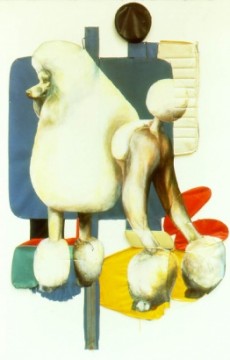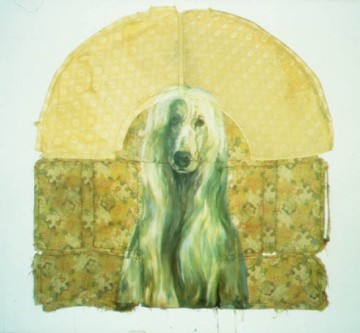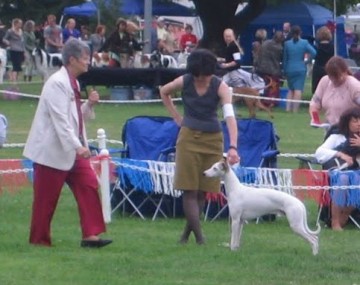
M.A. Peers, "Valentina," 1996. Oil on found sofa upholstery fabric (vinyl), foam stuffing, 123 x 74 inches. Courtesy Rosamund Felsen Gallery.
During last week’s panel discussion in conjunction with M.A. Peers‘s exhibition at the Pomona College Museum of Art, Peers recalled a pivotal moment during her graduate studies. Painter Linda Day told her to “paint the most embarrassing thing you can think of.” Hence, Peers’s ongoing series of mammoth dog portraits was—in the punny words of panel moderator Doug Harvey—“unleashed” from her psyche and studio.
Leading up to that point, Peers had exhibited only abstract, Combine-like amalgamations of scavenged domestic textiles. As a carless Canadian expat, Peers combed the sidewalks of suburbanly sprawled Los Angeles, hunting, gathering, and skinning various grotesque couches, chairs, and other castoff interior decoration. Peers’ practice collided the heroicism of New York abstract expressionist art jocks with the categorically ugly throwaways of the feminine private sphere.
Meanwhile, she had kept her passion for another marker of domesticity—and domestication—tightly under wraps. Having grown up working in kennels and showing dogs on the show circuit, Peers spent her whole life drawing and painting dogs privately. So when Day challenged Peers to shake up her practice by mining embarrassment, Peers (as recounted in her exhibition catalogue) “thought of an Irish setter.”

M.A. Peers, "The Gazehound," 1995. Oil on found upholstery fabric, 95 x 85 inches. Image via Rosamund Felsen Gallery.
In Dada-meets-Velázquez gestures, Peers collided the public and private threads of her practice, painting regal dog busts on grounds constructed in the same manner as her abstract assemblages. The size, iconic placement, and scavenged material all serve to distance the dog portraits from associations of sentimental kitsch. The paintings are more Pop than popular, inspired by dog food bag images of purebreds, and a far cry from Dogs Playing Poker.
There is an unsettlingly seductive tension within the work, which perhaps can be explained by a comment Peers made during the panel discussion. She revealed that, while painting a Rottweiler, she studied male fashion model print ads, searching for compelling gazes, positions, and design styles to inform the dog portraits.

M.A. Peers, "Ron Beegle, former Executive Vice–President, Gap, Inc. Direct," 2005. Acrylic on panel, 29 x 42 inches. Courtesy Rosamund Felsen Gallery
Perhaps this unlikely source of inspiration led her to embark on a subsequent series of portraits of corporate executives. The paintings dot-com founders and CEOs are painted in a variety of styles, from delicate, painterly monochromes, to stencil-like portraits that play with millennial-era tropes of graphic design. Continuing to toy with the complexities of contemporary masculinity, Peers subsequently embarked on her Found Yuppy series. This trajectory of borderline psychedelic, Rococo-colored portraits was inspired by the arrival of new neighbors, slowly invading Peers’s onetime heterogeneous area of residence on the east side of Los Angeles.

M.A. Peers, "Found Yuppie I," 2007. Oil and acrylic on found masonite, 48x48 inches. Courtesy Rosamund Felsen Gallery.
Peers’s most recent work, on display in the current exhibition, circles back to her roots. Dog portrait and abstract collage have again been separated into two distinct–but intangibly intertwined—threads. Viewers entering the exhibition are greeted by two large-scale abstract oil on canvas paintings, inspired by the infamous paranormal site Mel’s Hole. Though they are not built from found textiles, their surfaces are equally belabored, textured, and dynamic. The exhibition also presents three whippet-inspired works. But while Peers’s earlier portraits face outward, assertively mirroring the viewer’s gaze, Peers presents the new dogs entirely in profile. Thus, the paintings move away from the everyman advertising dog, and respond to the more esoteric realm of dog shows – a reference highlighted by the American Kennel Club diagram of an ideal show-whippet that greets viewers entering the exhibition.
The whippet paintings emerged when Peers acquired, partially by accident, a show-level whippet named Portfolio. I recently joined Peers at one of Portfolio’s competitions. Watching dogs, handlers, owners, and judges, I joked with Peers about the parallels between the dog show circuit and the art world. It was a bit like wandering through an art fair, where all participants (human or otherwise) are totally immersed in an oddball, self-enclosed, demanding, and competitive—but still friendly–society. The human personalities range from quirky to pretentious, and all interactions are pervaded by the stench of professionalism, obsession, and most of all, aesthetic pickiness. While Peers regards her parallel universes through her own critical and irreverent perspective, she seems to prefer the dog world.

Artist M.A. Peers is both the owner and handler of Portfolio the whippet, seen here at a 2009 dog show. Courtesy Doug Harvey.
Perhaps that is why she implies that her newest paintings are made in the service of understanding whippets. The exhibition catalogue quotes Peers likening the recent dog paintings to “architectural renderings” based on winning show whippets. Indeed, their precision and uncharacteristically plain paper grounds convey a degree of scientific detachment. But at 60×89 inches, with hallucinatory purple and teal shadows sneaking through the furry dog coats, the new paintings transcend Peers’s purported diagrammatic impulse.



